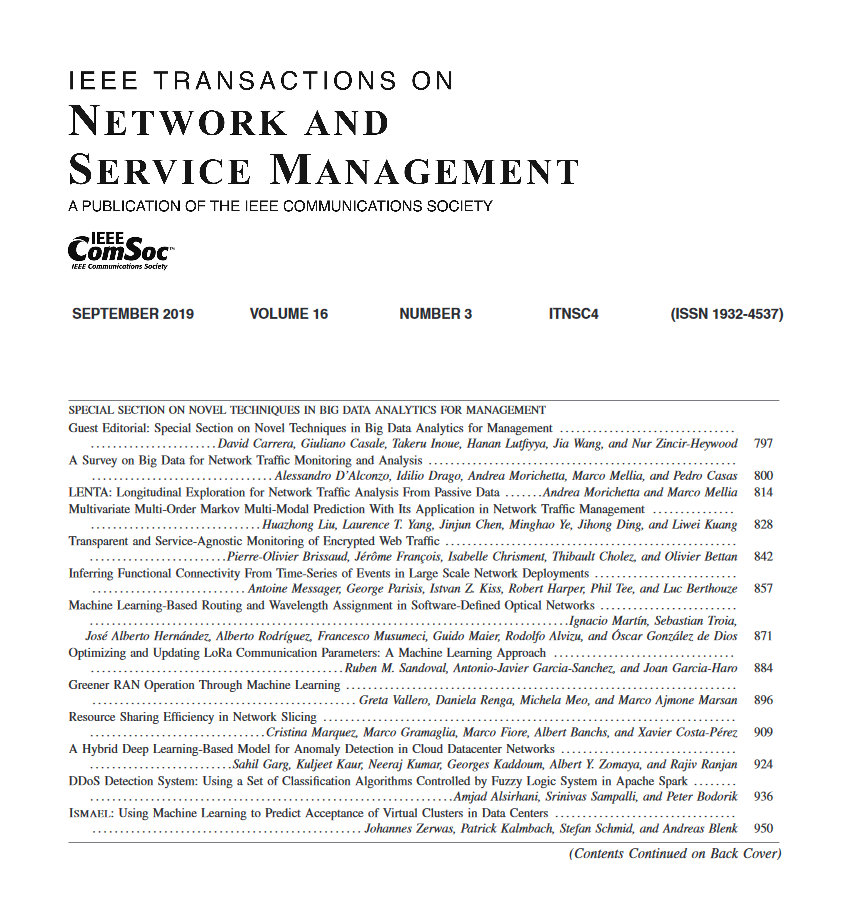DLAZE: Detecting DNS Tunnels Using Lightweight and Accurate Method for Zero-Day Exploits
IF 5.4
2区 计算机科学
Q1 COMPUTER SCIENCE, INFORMATION SYSTEMS
IEEE Transactions on Network and Service Management
Pub Date : 2025-02-12
DOI:10.1109/TNSM.2025.3541234
引用次数: 0
Abstract
Domain Name System (DNS) protocol is highly targeted nowadays for creating tunnels and extracting information from the intended machines. The reason for such exploitation is that DNS is passed unchecked by most firewalls and Intrusion Detection Systems (IDSs) to maintain the network’s quality of service. Most detection methods utilize the signatures of tunneled queries and tools for DNS tunnel detection. However, the new or updated tool versions bypass these signature-based methods. Moreover, DNS generally comprises a significant portion of total network traffic with a skewed distribution of legitimate DNS traffic against DNS tunnels. Thus, checking each DNS packet against signatures is a bottleneck to the efficiency of the network. To resolve this problem, we propose DLAZE, which can efficiently detect known and unknown DNS tunnels in the network traffic without compromising the efficiency of the network. DLAZE consists of a three-layer system. The first layer utilizes our already proposed work OptiTuneD, which filters out nearly all legitimate DNS packets with linear time complexity and solves the problem of the skewed distribution of legitimate vs tunneled DNS. The remaining packets are passed to the second layer, which uses the Bidirectional Encoder Representations from Transformers (BERT) model to identify legitimate DNS packets that remained unidentified at the first layer with the quadratic time complexity. The third layer obtains only unknown or zero-day DNS packets that can be legitimate or tunnels, which are differentiated using the Probing method with constant time complexity. We tested DLAZE using three publicly available datasets. The experimental results show that the average recall, precision, and F1-score obtained on all three datasets are 98.74%, 97.46%, and 97.95%, respectively, with the average processing time for each DNS packet as 473.25 milliseconds.使用轻量级和精确的方法检测DNS隧道的零日攻击
目前,域名系统(DNS)协议是创建隧道和从预期机器提取信息的高度目标。这种利用的原因是,大多数防火墙和入侵检测系统(ids)为了保持网络的服务质量而不检查DNS。大多数检测方法利用隧道查询的签名和工具进行DNS隧道检测。但是,新的或更新的工具版本绕过了这些基于签名的方法。此外,DNS通常占总网络流量的很大一部分,合法DNS流量相对于DNS隧道的分布是倾斜的。因此,对每个DNS报文进行签名检查是影响网络效率的瓶颈。为了解决这个问题,我们提出了blaze,它可以在不影响网络效率的情况下有效地检测网络流量中的已知和未知DNS隧道。blaze由三层系统组成。第一层利用我们已经提出的工作optitune,它过滤掉几乎所有具有线性时间复杂度的合法DNS数据包,并解决了合法DNS与隧道DNS的倾斜分布问题。剩余的数据包被传递到第二层,第二层使用来自变压器的双向编码器表示(BERT)模型来识别在第一层仍未识别的合法DNS数据包,其时间复杂度为二次。第三层只获取可能是合法或隧道的未知或零日DNS报文,使用时间复杂度恒定的探测方法进行区分。我们使用三个公开可用的数据集测试了blaze。实验结果表明,在三个数据集上获得的平均查全率、查准率和f1分数分别为98.74%、97.46%和97.95%,每个DNS报文的平均处理时间为473.25毫秒。
本文章由计算机程序翻译,如有差异,请以英文原文为准。
求助全文
约1分钟内获得全文
求助全文
来源期刊

IEEE Transactions on Network and Service Management
Computer Science-Computer Networks and Communications
CiteScore
9.30
自引率
15.10%
发文量
325
期刊介绍:
IEEE Transactions on Network and Service Management will publish (online only) peerreviewed archival quality papers that advance the state-of-the-art and practical applications of network and service management. Theoretical research contributions (presenting new concepts and techniques) and applied contributions (reporting on experiences and experiments with actual systems) will be encouraged. These transactions will focus on the key technical issues related to: Management Models, Architectures and Frameworks; Service Provisioning, Reliability and Quality Assurance; Management Functions; Enabling Technologies; Information and Communication Models; Policies; Applications and Case Studies; Emerging Technologies and Standards.
 求助内容:
求助内容: 应助结果提醒方式:
应助结果提醒方式:


